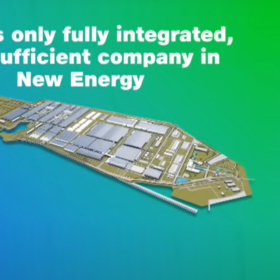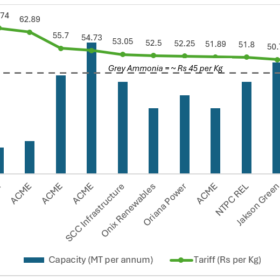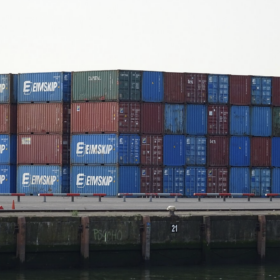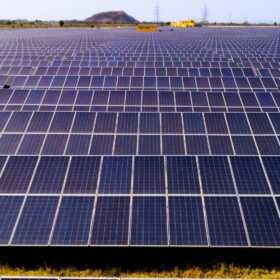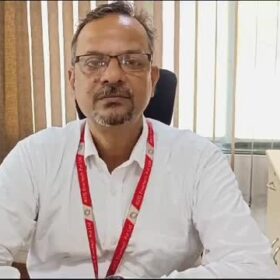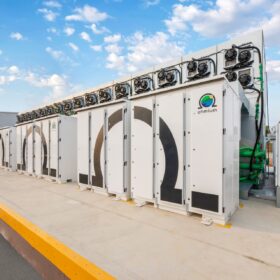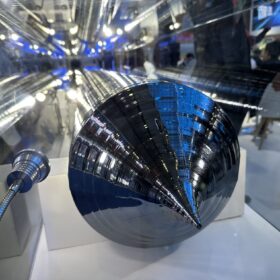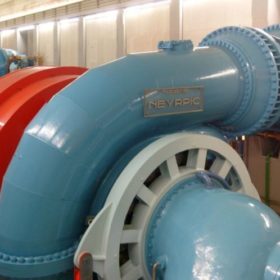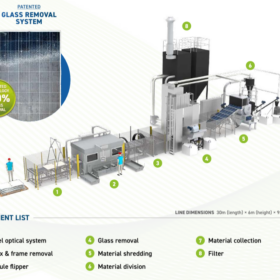Reliance Industries Ltd’s battery gigafactory set to begin operations in 2026 with an initial annual capacity of 40 GWh
Reliance Industries Limited (RIL) is set to begin production at its upcoming battery gigafactory in 2026, with an initial annual capacity of 40 GWh. The facility will later be modularly scaled up to 100 GWh per annum, announced Anant Ambani, executive director of RIL, during the company’s annual general meeting recently.
Everest Industries invests in solar plant for captive consumption
Everest Industries, a building solutions company in India, has invested INR 1.76 crore in Amplus Ampere (Amplus), a special-purpose vehicle (SPV) created by Amplus Energy Solutions to set up a solar power plant for group captive consumption.
Green ammonia is only 10% costlier than grey in the latest SIGHT Mode 2A auctions
The lowest green ammonia price discovered so far in the SIGHT Mode 2A auctions is just 10.1% higher than the current grey ammonia prices in India (US$515 per MT). Notably, the low cost of Rs 49.75 per kg in the Mode 2A auctions is almost half of a similar green ammonia auction conducted by H2Global in 2024, suggesting an imminent price parity between grey and green ammonia.
US trade court orders retroactive solar duties on Southeast Asian imports
The US Court of International Trade has ruled that the Biden administration’s two-year suspension of solar duty collections was unlawful, clearing the way for retroactive tariffs on billions of dollars of solar gear from Southeast Asia.
India installed 18 GW solar in first half of 2025, says Mercom report
India added 18 GW of new solar power capacity in the first half of 2025, with over 11 GW installed in the second quarter alone.
India finalizing CCUS Mission roadmap, outlay
The Union Government is finalizing the roadmap and financial outlay for the much-anticipated Carbon Capture, Utilisation and Storage (CCUS) Mission, said Rajnath Ram, Adviser for Energy, Natural Resources & Environment at government policy thinktank NITI Aayog.
India’s solar EPC evolution: Why boutique firms are attracting institutional capital
Boutique EPC companies prioritize efficiency, customization, and site-specific solutions, and they frequently outperform their larger counterparts in terms of cost-performance ratios.
Ohmium unveils new electrolyzer system with compact horizontal footprint of 29.7 m²/MW
Ohmium’s Lotus Mark 3 electrolyzer system with a compact land usage area of just 29.7 m2 per MW, including space for maintenance and access, sets new industry standard for land usage efficiency.
Green collar careers: Powering India’s workforce for a sustainable future
Studies, including one by Deloitte, show that 80% of the skills required for green collar jobs already exist in India’s current workforce. With the right upskilling, these capabilities can be unlocked to help millions shift into meaningful, future-ready careers.
“We are in the process of establishing a sodium-ion battery cell pilot line by 2026″: Macsen Labs CEO
Achal Agrawal, CEO of Macsen Labs, a chemical company making bold strides into battery materials, speaks to pv magazine about the potential of sodium-ion batteries for energy storage, their journey developing Prussian White cathodes, and plans to scale this technology.
